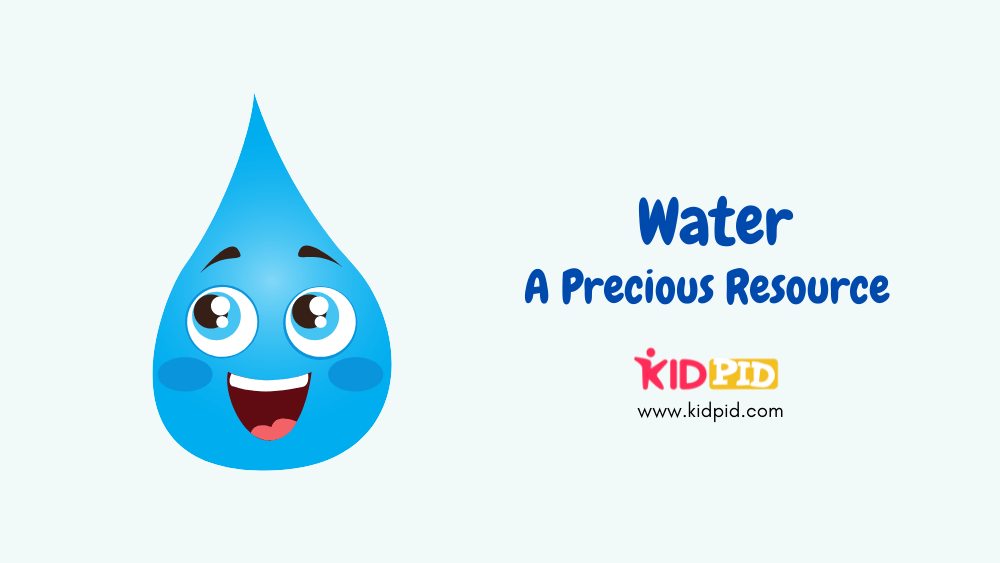Water is the most essential substance for the existence of life. Water is essential for the survival of any living organism, be it a plant or an animal. Plants need water to make their food by the process of photosynthesis. Seeds need water to germinate or grow into seedlings. In animals, water is needed to digest food, to cool the blood water. In our body is mostly water and so dissolve many salts in our body. Water also helps to keep our muscles and joints running smoothly.
We use water for many other purposes such as bathing, washing, cooking, cleaning and manufacturing process in factories.
Contents
Importance Of Water For Life
Water is a renewable natural resource. About 70% of the human body is water. Water is essential for life. Some of the most common uses of water are as follows:
- Plants and many other tiny creatures prepare their food by the process of photosynthesis and release oxygen into the atmosphere.
- In animals and human beings, water regulates body temperature by the process of sweating.
- Water is needed to digest food, carry digested food and wastes, dissolve all minerals and carry them to the required place of the body.
- Water is used as a universal solvent.
- Water is used for irrigation.
- Water in the radiator of a car helps in keeping its engine cool.
Sources Of Water
1. Oceans and Seas
Oceans and seas are the largest source of water which cover more than the two-third surface of the Earth. This has large amounts of various salts. That is the reason that ocean water is salty and it is called saline water and not used for general purposes.
2. Rain and snow
Rain and snow are the purest forms of all-natural resources of water. Water is present in the form of ice in polar regions of the earth. In our country, there are many areas where farming is possible only when it rains. Hence, water from rain is used for irrigation purpose.
3. Ground Water
Groundwater depends upon the rain. Some quantity of rainwater goes into the earth till it meets a layer of rock and collects and forms a reservoir. This reservoir of water over the impervious rock below the soil is called aquifers and the water is called underground water.
This water is pumped out and used for different purposes. The level of underground water below the surface of the earth at any place is known as the water table.
4. Surface Water
Surface water is present on the surface of the Earth. Surface water takes the shape of rivers, lakes, ponds, canals and springs. Surface water is not fit for drinking and cooking.
5. Spring Water
The major part of the rainwater accumulates over the impervious rocks under the earth. This water exerts pressure and comes out in the form of spring from any available opening. This water is called spring water.
States Of Water
Water occurs in all three states- solid, liquid and gas. Water in the form of ice and snow occurs on the peaks of mountains and in polar regions such as Antarctica. Water occurs in oceans, seas, lakes, ponds, springs, wells, rivers, etc. in liquid form. Liquid water covers the nearly three-fourth surface of the earth.
- Water exists as water vapour or steam in the gaseous state.
- Water exists in the form of ice as solid at or below 0ºC.
- Water exists mostly in a liquid state in between 0ºC and 100ºC.
- Water exists in the gaseous state as steam at above 100ºC.
- The three states of water are interchangeable.
- Water can be changed from one form to another at different temperatures.
- Ice on heating changes to water and cooling, water changes to ice.
- Water on heating changes to steam and cooling, steam changes to water.
The Water Cycle
Water is a renewable resource. In nature, water circulates continuously. However, it keeps changing its state and location in a cyclic pattern. The continuous circulation of water from one form to another in nature is called the water cycle.
The water in the seas, oceans, rivers, lakes, ponds, etc. gets evaporated continuously into the atmosphere due to the heat of the sun. Water vapours being lighter rise upward with warm air and form clouds in the sky. This is called evaporation. The clouds are carried by air through long distances. When the clouds cool down further, water vapour condenses into water droplets and fall to the ground as rain. This is called precipitation. In colder weather, the water drops may freeze and fall as hail or snow.
The rainwater finds its way back into the rivers and seas. Some quantity of rainwater accumulates underground as groundwater. Groundwater is pumped out for various purposes and eventually settles into the rivers and then finally comes into in oceans. This circulation of water from the surface of the earth to the atmosphere and back to the earth is called the water cycle. Through the water cycle nature maintains the balance of water on the earth.
Physical Properties Of Water
Some physical properties of water are as follows:
- Pure water is a colourless, odourless and tasteless liquid.
- Pure water is a transparent liquid.
- Water exists in three forms- solid, liquid and gas.
- Pure water freezes to ice at 0ºC under atmospheric pressure but soluble impurities lower the freezing point of water.
- The melting point of pure water is 0ºC.
- Water boils at 100ºC but soluble impurities raise the boiling point of water.
- Pure water does not conduct electricity.
- Water is known as a universal solvent, because it can dissolve a large number of substances.
